
archives for 05/2017
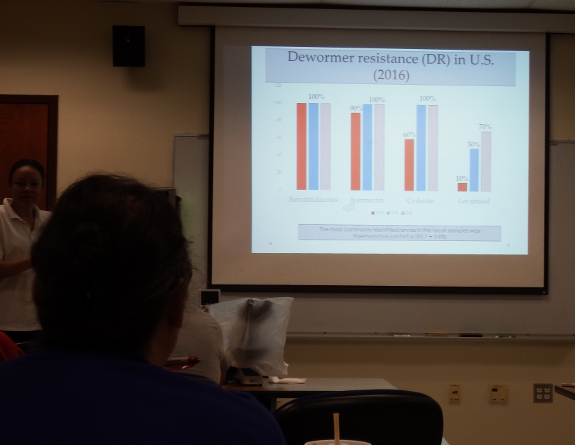
As I learned the hard
way, you can use all kinds of holistic methods to keep sheep and goats
healthy but at some point you'll end up having to rely on
pharmaceuticals. Although it wasn't our issue last year, the most
common problem requiring that step in our region is internal parasites
--- worms.
The trouble is,
dewormers have been used with such wild abandon in the U.S. that many
don't work any longer. The worst offender --- barberpole worm --- was
found to be resistant to three of the four classes of dewormer in every
farm studied last year in Virginia and Georgia. Only the nicotinic
agents (Levamisole) were still effective in that study, and even that
class only worked in 30% of Georgia farms and 50% of Virginia farms.
The benzimidazoles (such as Safeguard) and the macrocyclic lactones
(such as Ivomec and Cydectin) are now useful only for lesser parasites
such as tapeworms.
Luckily, there are a few
methods available to make supposedly ineffective drugs more effective.
First of all --- don't use them! The
alternatives mentioned last year are still a good first step, along
with pasture rotation. And, of course, you should use a FAMACHA
test so you'll only treat individuals that have a high worm load.
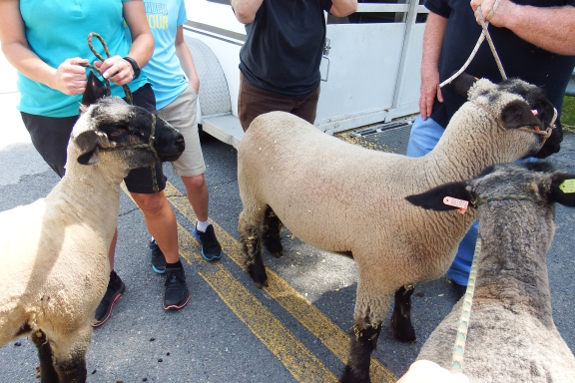
But what if you have a
sheep or goat that is dangerously anemic due to barberpole worms...and
your farm is showing resistance to all of the available drugs? First of
all, make sure you're dosing properly. Even though it doesn't say so on
the bottle, goats have a higher metabolism than sheep and should be
given twice as high a dose on a body-weight basis as sheep should (or
1.5 times as much for Levamisol). Using less just speeds up dewormer
resistance on your farm.
Second, you can prolong
the efficacy of certain drugs even if there's already some resistance
to the drug on your farm in a few different ways. Keeping your animal
off feed for twenty-four hours before dosing will make the drug more
effective since food dilutes the dewormer. Second, you can give a full
dose of Safeguard then repeat in twelve hours, which was shown in one
study to increase the kill rate of the dewormer from 50% to 92%. (With
Levamisol, you'll want to wait 24 hours before repeating, while
repeating didn't prove effective for the other classes.)
Finally, you can double
up different classes of drugs to kill off a lot more worms. For
example, if parasites on your farm are resistant enough to three
different drugs so each one only kills 60% of the worms, dosing with
all three drugs at once will eliminate over 90% of the problem ---
pretty good for dewormers that you probably considered useless on your
farm!
I hope the worms never
get bad enough on our farm that I have to use this information...but
I'm posting anyway in case either I (or you) do go there. Good
luck...and please never deworm willy-nilly without testing each animal
first to see if he or she needs it.
(Information courtesy of
Dr. Dahlia O'Brien, Small Ruminant Specialist for the Virginia
Extension Service...and really good speaker. If you get a chance to
attend one of her workshops, I highly recommend it!)
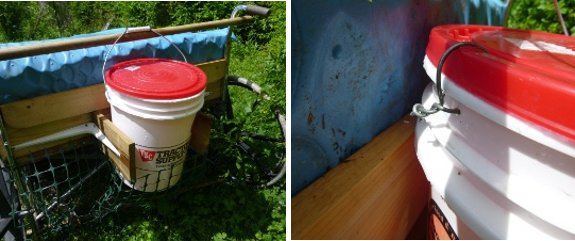
The 5 gallon bucket waterer
got a little warped creating a lid falling off problem.
A galvanized wire loop should
hold it in place when we move it at night.
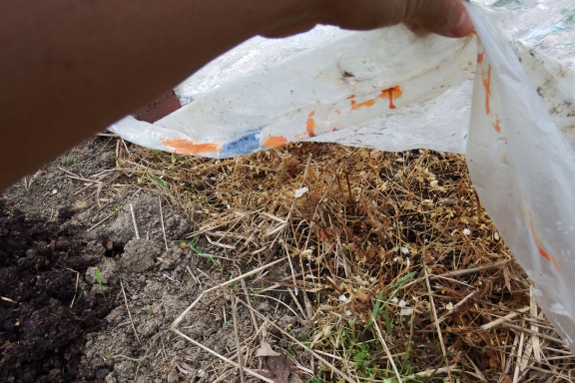
Many gardening shortcuts
create more work in the long run, but a few make the cut for our
homestead. First up --- solarization season is upon us again,
with low-lying weeds like chickweed dying in a week under clear
plastic. (Yes, this is the same dropcloth I used to paint
our living room last
winter. No waste here!)
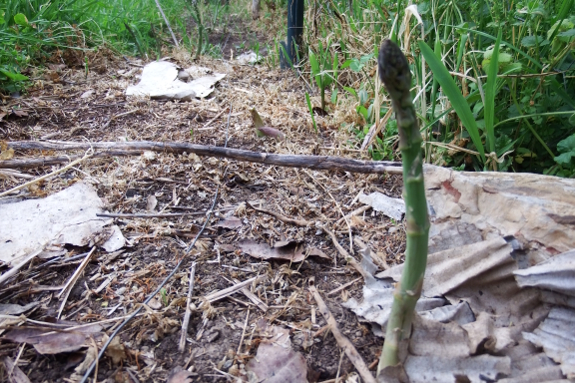
Meanwhile, I finally
found an effective use for the Weed
Dragon. The
flame weeder did next to nothing against established weeds, and I usually depend on
mulch to kill off bad seedlings. The exception is in the asparagus
beds, where soil stays bare for over a month during harvest season.
Weed pressure is terribly high there as a result...but perhaps not any
more?
I weeded the asparagus
bed well two weeks ago, but new seedlings popped up in short order. Not
a problem with the Weed Dragon on hand! Just pick every spear, flame
the bed hard, and the soil is once again nearly weed-free. Only
problematic runnering grasses are still coming up. Maybe another round
or two of flame weeding will do the trick on those?

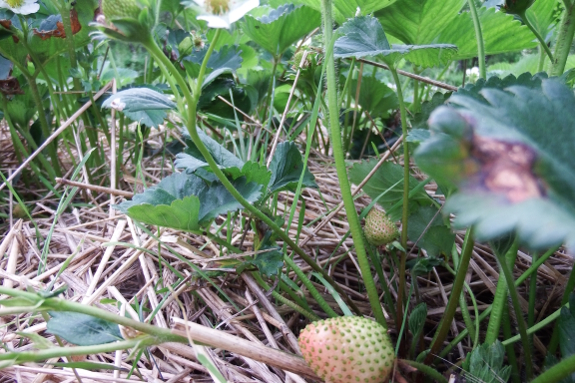
The first strawberries
are just barely blushing pink...
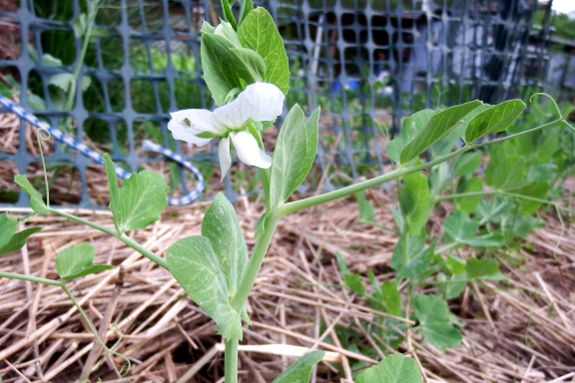
...the first peas are
beginning to bloom...
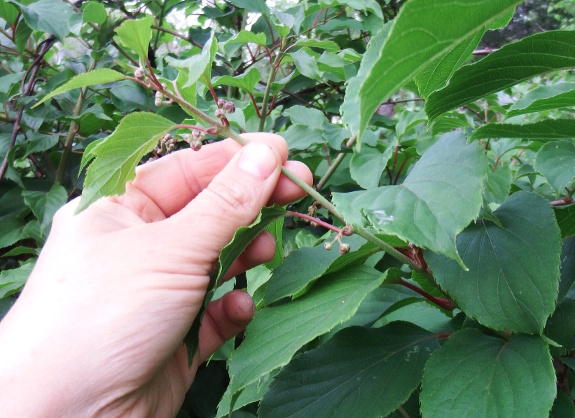
...and the hardy kiwis
have more than a few bloom buds this year. If the upcoming Blackberry
Winter plays nice, we may enjoy some tasty treats later in the month.
We retired our problem egg
eating hen only to realize she had a partner in crime.
The new plan is to try to
collect the eggs as they get laid in hopes of the criminal hen
forgetting about the egg eating process.
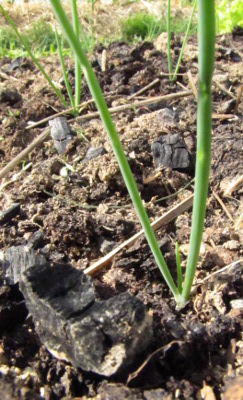 Do you remember the biochar
craze from a few years ago? Everyone from Mother Earth News to the Extension
Service was touting charcoal's benefits as a soil amendment, and if you're like us you
probably tried it in your own garden.
Do you remember the biochar
craze from a few years ago? Everyone from Mother Earth News to the Extension
Service was touting charcoal's benefits as a soil amendment, and if you're like us you
probably tried it in your own garden.
After a few trials, my
conclusion was that biochar didn't provide any visible benefit to our
soil beyond a very slight warming effect for extremely early spring
crops. And, to my
surprise, science now backs that assertion up. A
comparison of over a thousand biochar studies concluded that biochar
has no discernable benefit in temperate regions (although it does help a lot in tropical soils
where high heat and rainfall mean that organic matter decomposes and
nutrients leach away in short order).
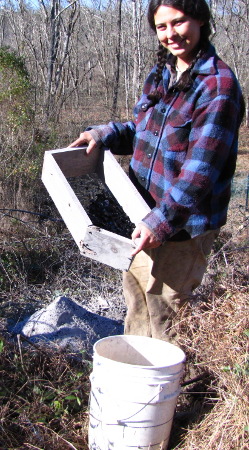 So
will I stop sifting charcoal
out of my wood ashes
to apply to the garden? Probably not. Like any other source of organic
matter, biochar improves soil texture over the long run, and processing
the waste from our wood stove only takes about half an hour per year.
So
will I stop sifting charcoal
out of my wood ashes
to apply to the garden? Probably not. Like any other source of organic
matter, biochar improves soil texture over the long run, and processing
the waste from our wood stove only takes about half an hour per year.
But I'm glad I didn't burn wood specifically for the purpose of
creating biochar. After all, hugelkultur builds soil fertility even
more and is a good fit for already punky wood. So bury that wood
instead of burning it if you want to boost your soil the best!
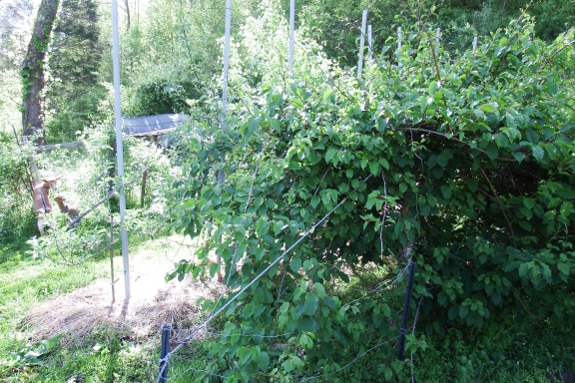
Our three hardy kiwi
bushes have been in the ground for nine long years without offering a
single fruit. We
did see a few flowers in 2014, but none appeared on the
male plant and the female flowers eventually dropped off. I keep saying
we're going to rip the plants out...but Mark likes them and they're
very little work, so I've left them alone.
This past winter, I
started wondering whether the problem could be our winter-pruning
method. Were we cutting off all the blooms before they had time to set
fruit? To test that hypothesis, I didn't prune at all this past
winter...and to my surprise I did indeed see numerous flower buds on
the male and on one female this spring!

After carefully pruning
off excess growth while leaving the flower twigs behind, though, I've
decided that I probably wasn't removing all of the flower
buds in previous rounds of pruning. Because what I mostly cut off is
long, vigorous vegetative growth like this...
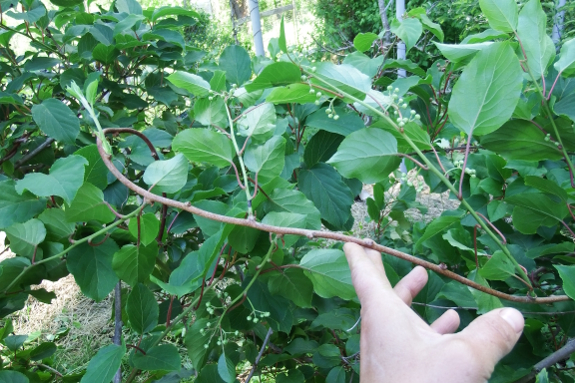
...but in only one
instance did I find kiwi blooms emanating from what I would have
considered a watersprout-to-be-pruned.
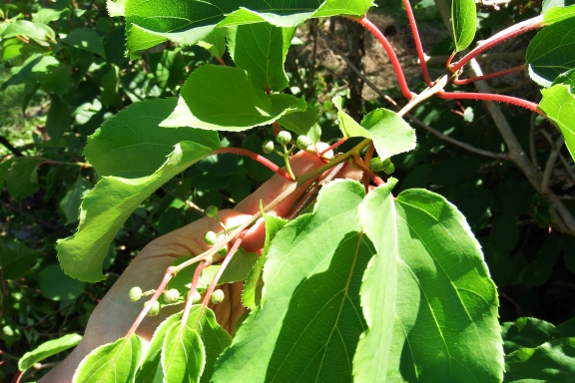
Instead, most flowering
shoots are on small, sheltered branches hidden deep within the kiwi
bush.
So I'm back to
hypotheses A and B, both of which revolve around problematic
late spring frosts. Either the April and May freezes that
inevitably nip back the kiwis' spring growth have slowed the maturity
of the vines, or the plants have been ready to fruit for years but
their flower buds are what get nipped during those late freezes. Maybe
we'll get lucky and bypass the possible frost this weekend so the
plants can avoid either of those issues for one year?
A hole in the top of the PVC
run allows for the insertion of the roofing structure.
An exterior screw going in
from the side and biting into both pipes holds it in place.
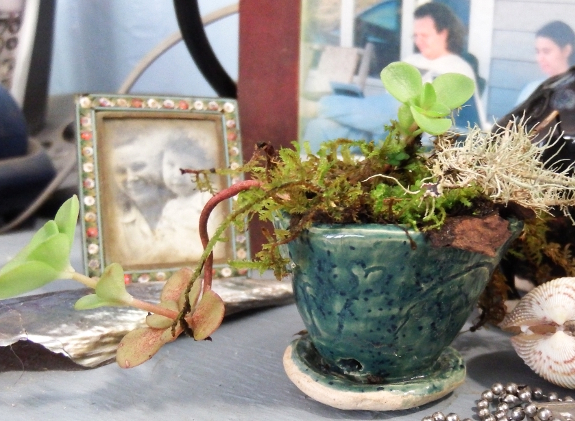
My second finished piece
from clay class was a tiny pot too small for
any plant except moss (and a sprig of sedum). I had fun picking three
species of moss out of the woods then adding a bit of fallen lichen to
complete my miniature arrangement. Surprisingly, all inhabitants have
thus far survived on daily drips of water in a low-light corner of my
office. The moss garden --- even smaller and more intricate than a
bonsai.
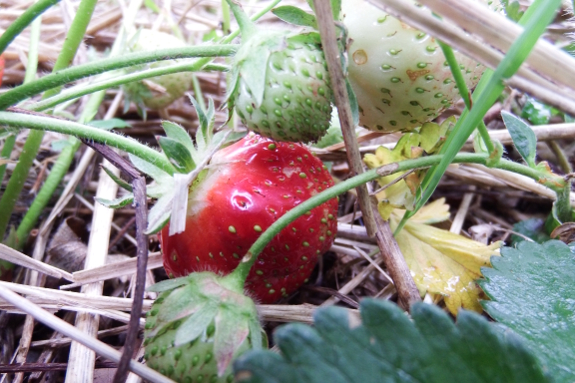
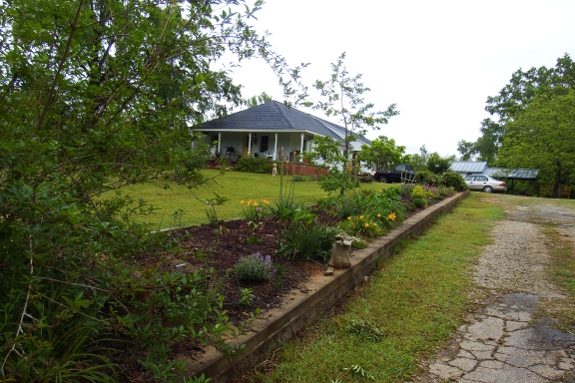
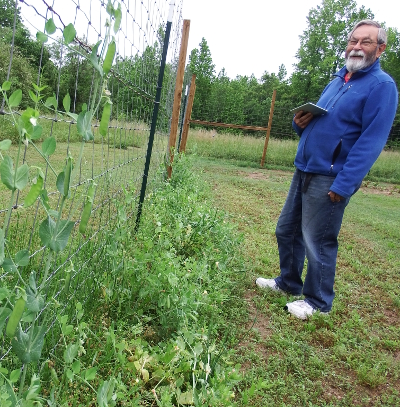 Mark and I autoscheduled our
posts, filled the feeders and waterers, then snuck away for a quick
trip south to visit Daddy and Barbara. The visit was just what the
doctor ordered...and not just because South Carolina strawberries are
in full swing and I was treated to a homemade/homegrown strawberry pie.
(Yum!)
Mark and I autoscheduled our
posts, filled the feeders and waterers, then snuck away for a quick
trip south to visit Daddy and Barbara. The visit was just what the
doctor ordered...and not just because South Carolina strawberries are
in full swing and I was treated to a homemade/homegrown strawberry pie.
(Yum!)
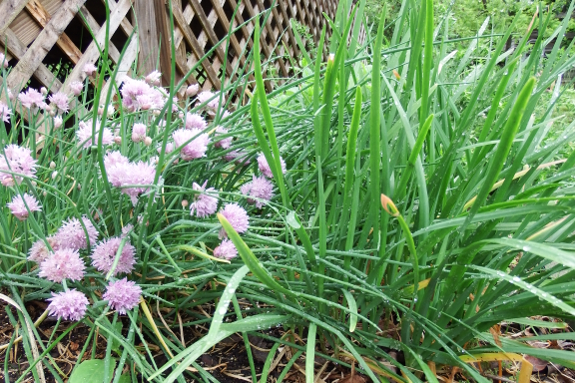
For family members --- I
highly recommend visiting this five-star resort as soon as possible.
Two thumbs up!
For those of you who
actually read this blog to learn about homesteading, I came home with a
start of garlic chives (shown on the right above, with normal chives on
the left for comparison). This perennial looks like a great addition to
the zone 3 to 10 herb garden since it blooms in summer (meaning you can
pick garlic chives while the other variety is blooming in spring) and
it apparently thrives even in a dry climate. Now to see how well garlic
chives do in our swamp!
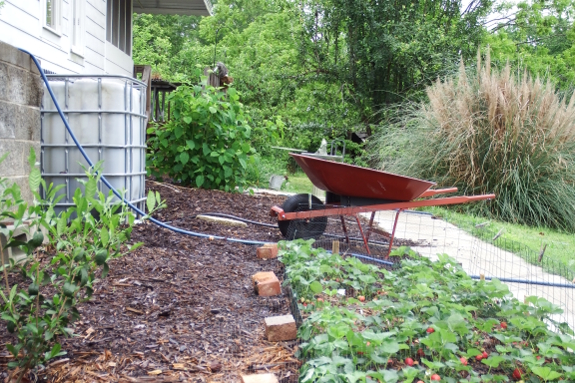
The other tidbit I
wanted to share from my
South Carolina visit pertained to rainwater harvesting. Daddy's
climate is very drought-prone and his sandy soil means that whatever
rainfall hits the earth is gone in short order. Since he uses a well
for household water, there's a limit to how much he can divert for
irrigation purposes. Enter rainwater catchment, both in the form of the
rain
barrel shown above...
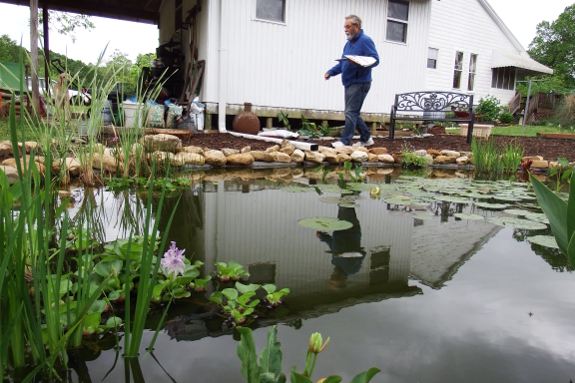
...and by channeling
gutter overflow directly into his water garden.
The oasis Daddy and
Barbara have created using minimal water is truly inspiring. I hope you
enjoy seeing rainwater catchment in action!
The Petmate two door top load kennel was
easy to put together and lightweight.
We took Huckleberry in for a
vet visit today. The doctor says he's fine.
Much better than the pillow
case we used last time.
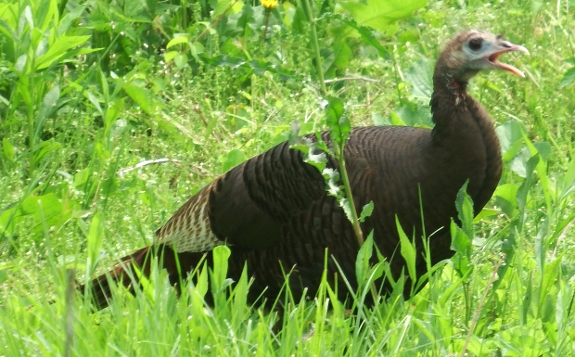
Our garden is full of
life in the spring...just perhaps not the kind of life I was hoping
for. This turkey, for example, has been showing up every other day for
over a week. She'd better not go after our strawberries because there's
still a week of spring turkey season left. Just saying....
We decided to ratchet strap the Super Winch up front in case we need it again.
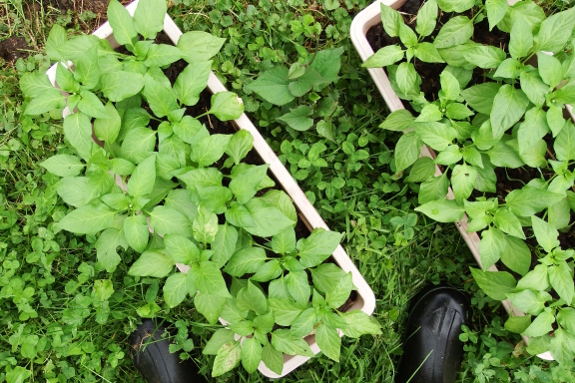
We survived Blackberry
Winter unscathed! The weekend was a close call, with a low of 33, but
it looks like 2017's ultra-early spring is going to continue unabated.
Time to set out all those seedlings that have been growing like
gangbusters under
our elevated sofa
for the last couple of months.
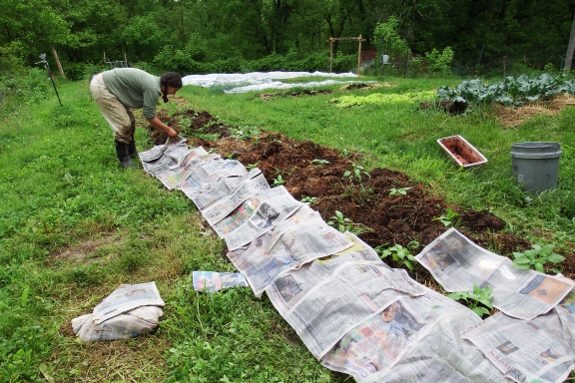
The lunchbox peppers are
loaded with bloom buds, so they were the first to hit the dirt. I set
out transplants in a bit of an experimental/slapdash manner, though, so
I hope they're able to get their feet under them and continue to grow.
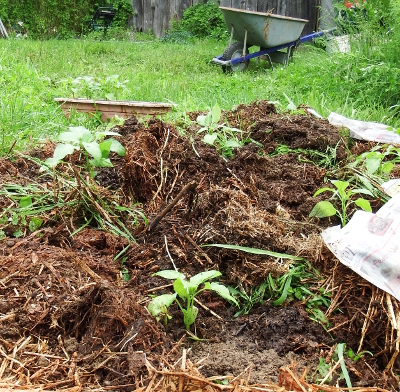 The bed they're in was very
weedy kale two weeks ago, at which point I mowed the plants close to
the ground then ran the chicken tractor across the soil. The result was
somewhat scratched earth but with lots of living weeds still
interspersed.
The bed they're in was very
weedy kale two weeks ago, at which point I mowed the plants close to
the ground then ran the chicken tractor across the soil. The result was
somewhat scratched earth but with lots of living weeds still
interspersed.
Next up, I topdressed
copiously with half-rotted goat-barn bedding. Then I raked back spots
to transplant the peppers into, laid down wet newspaper around the
transplants and topped it all off with a healthy helping of straw. Lots
of layers --- definitely a lasagna garden.
Now to see if the weeds
die nicely and the half-rotted bedding is rich enough to feed my hungry
peppers. If not, I've got six plants waiting in the wings as backup.
Here's hoping I don't need them!
One of our hens in the
wheelchair chicken tractor has figured out how to escape.
I think it's a space under
the nest box which needs to be fixed.
She's been staying close to
her sisters and away from the garden and should be easy to herd back in
after the flock gets roosted up for the night.
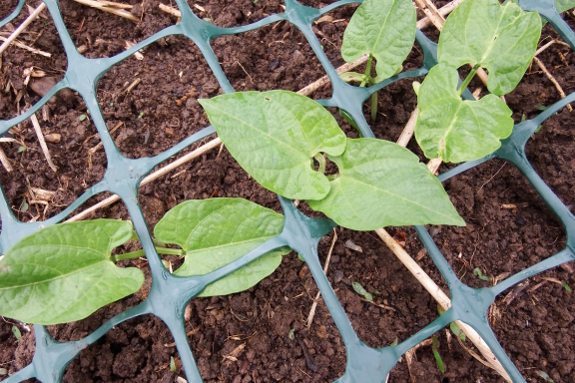
I gambled pretty hard on
an early spring...although, in my defense, nature did too. Planting
beans, corn, summer squash, and 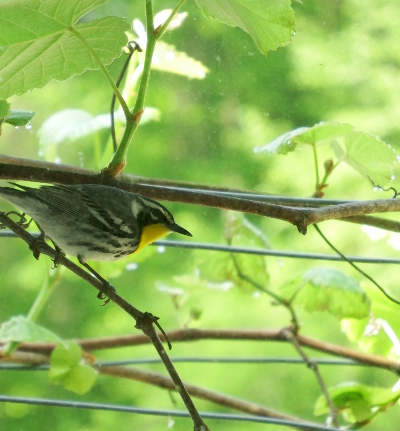 cucumbers on April 24 means
our first round of summer crops is already up and running.
cucumbers on April 24 means
our first round of summer crops is already up and running.
Meanwhile, the
grapevines on the shade
trellis are growing
like gangbusters (and attracting warblers to clean bugs off their
leaves). Our Reliance
vines gave us two small fruit clusters last year, but now they're coated in
flower buds. I can hardly wait until the view out our front window is
dripping with fruit!
The plan for these PVC parts include a feeder for the wheelchair chicken tractor.
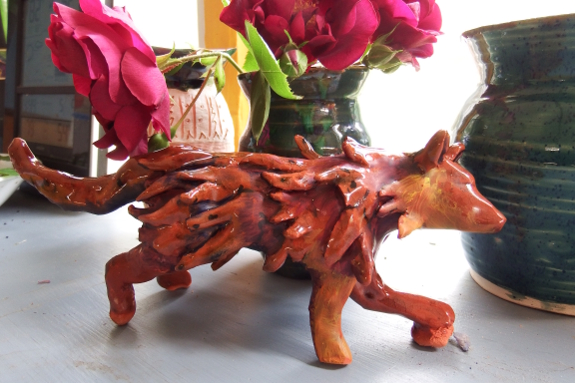
Another round of finished pieces
came out of the kiln this week. Some glazes worked better than others,
but my wolf (perhaps more of a fox?) did pretty well...
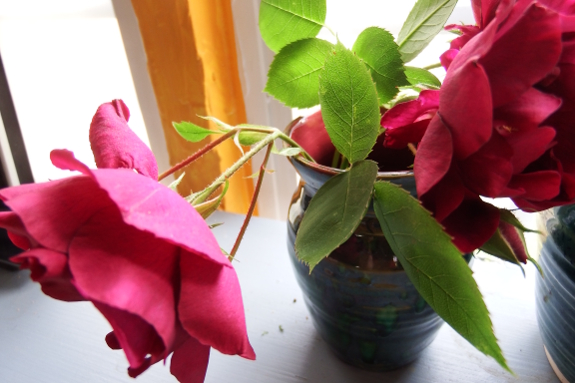
...and so did this vase,
just the right color for the roses now starting to bloom.
I think I have one more
set of creations waiting to be fired, then I'll have to share paintings
(if any of those end up blogworthy). After that, we get a short foray
into stained glass, then this wonderful class will be complete.
We've had a regular visitor
every day this week.
This yellow throated warbler
has claimed our shade
trellis as his own.
He seems to see his
reflection in the window and tries to chase it away.
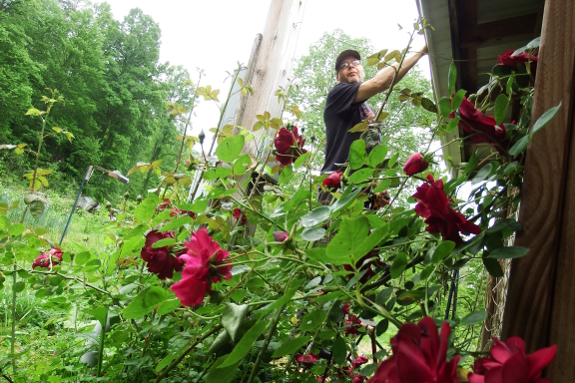
Cutting back our 2017
garden to just the crops we really need has helped free up quite a bit
of time around the farm. The result is a new tradition --- energy leak
Fridays.
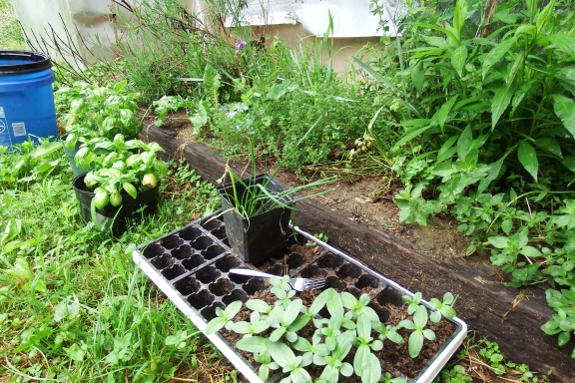
The idea is to take a
few hours once a week to run through small tasks that aren't really
important enough to go on the big list. Like, you know, cleaning the
house. Or, as we did this week, fixing a problematic gutter so I could
create a flower bed out of a spot that had been pure rose bush and
weeds previously, then cleaning up the nearby herb bed as well.
It's astonishing how
much joy I get out of having the areas I walk through most frequently
in tip-top shape. Now to see how long the energy leak Friday tradition
lasts.
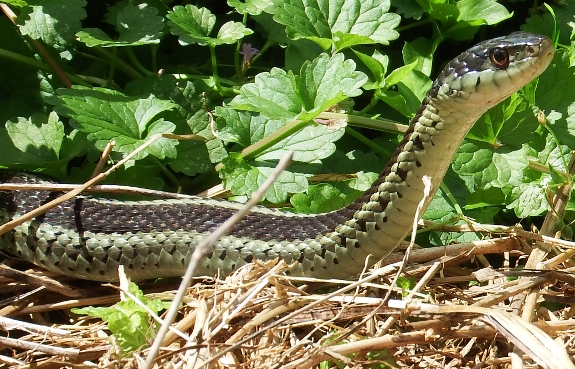
This garter snake has been
living in the straw mulch of a patch of strawberries.
Maybe she could scare away
some of the birds that swoop down for a quick snack.
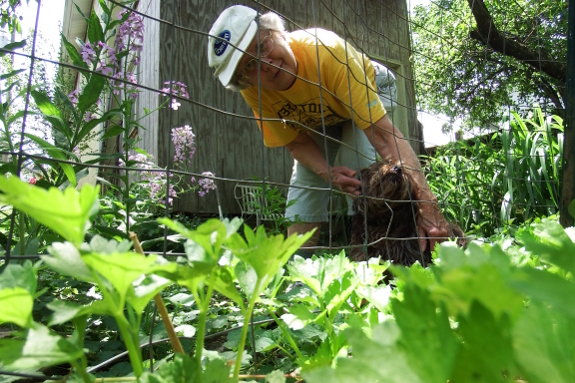
Happy Mother's Day to
the world's greatest mom! Grower of celery, reader of books, and
nurturer of every living thing nearby. I'm so lucky to have you in my
life.

And Happy Mother's Day
to my bonus mothers as well! Because you can never share too much love and I hit the jackpot when I added you to my cheer squad.
I hope every mother out there has a perfect day. Meanwhile, sons and
daughters --- don't forget to call Mom!
I caught another egg eating
hen in the act yesterday and isolated her.
Today is the first day in a
while that we got eggs without any signs of hen eating.
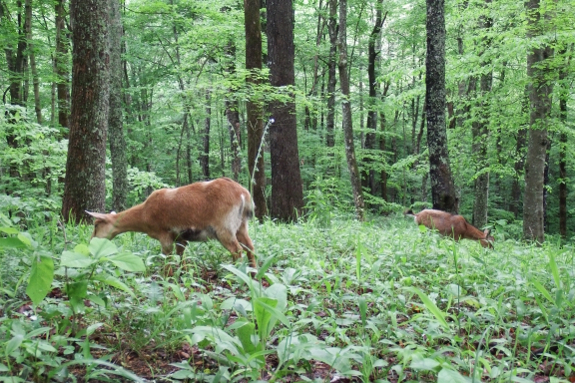
When nearly two inches
of rain push the creek up out of its banks yet again, the goats and I
head to higher ground.
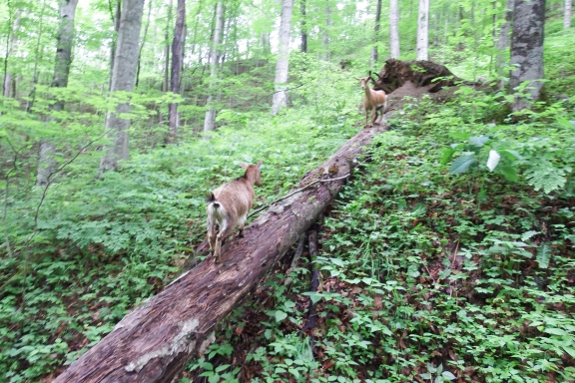
"Oh boy, a wet log to
climb on!" they exclaim as I cringe and hope they don't break a leg.
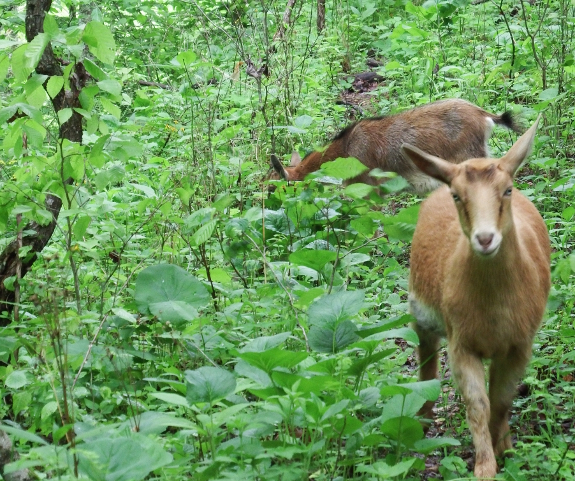
Woods grazing isn't as
high calorie as yard grazing, but I can almost feel our little herd
stocking up on hard-to-come-by micronutrients. Plus, there are fewer
things more joyful than lounging in the forest with two exuberant goats.
The wheelchair chicken tractor PVC feeder can hold half a gallon of laying pellets.
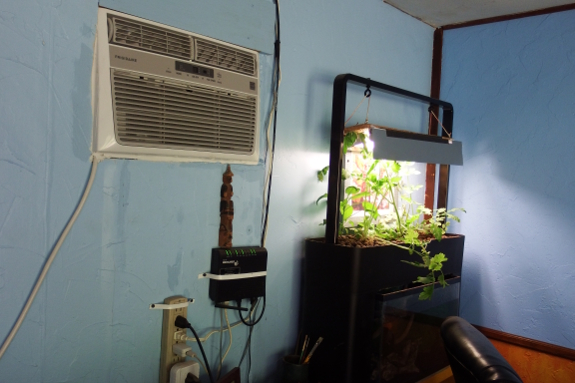
With 20/20 hindsight,
I've concluded that a partial cause of last summer's stomach troubles
was simply heat stress. We used to see only a few days each summer when
highs exceeded 90...but last year we instead had to deal with weeks of
that weather with no relief in sight. When similar highs began in April
this year, I decided to lower my standards and buy an air
conditioner.
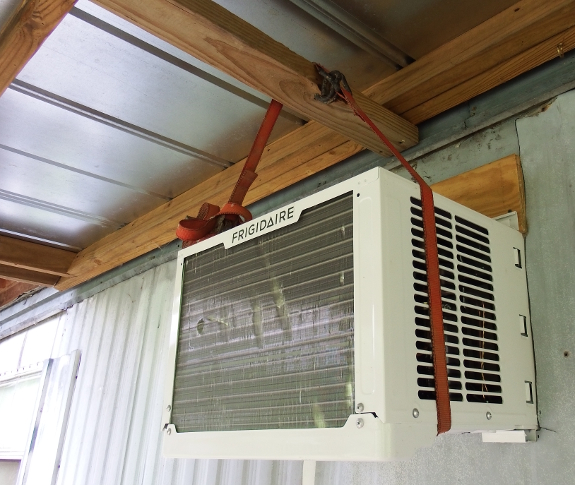
Mark already has an AC
in his man cave, so he knew exactly how to put one into odd spaces. In
true Trailersteading style, he installed my unit
by cutting a hole in the wall then chinking back in around it until the
air conditioner became a permanent part of our living space. No air
leakage there!
Although I felt
exceedingly guilty when I turned the unit on the first time, I quickly
realized two things. Using basic passive
cooling techniques
and setting the thermostat at 74 means the AC only runs for short
intervals even on the hottest days. Plus, since my brain shuts down
once my living space rises above about 83, the air conditioner has more
than paid for itself by increasing my writing time. I suspect this will
be another one of those modern
conveniences I learn
to love...as long as we keep the energy use within reason.
Sometimes the eggs won't roll
down due to the tractor being on uneven ground.
That's why I decided to make
this access door for a closer inspection.
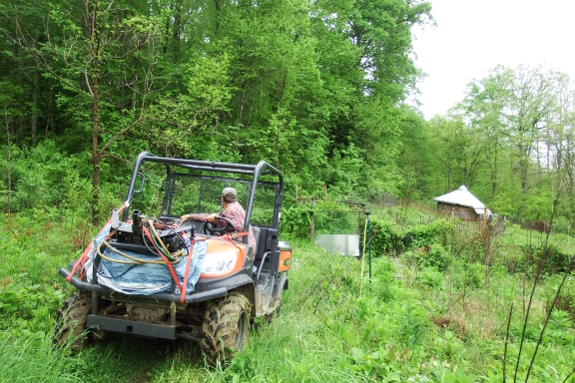
All of the
horse manure we hauled in earlier in the year was gone by the beginning of
May. And, unfortunately, the floodplain got wetter
instead of drier during that time period.
Luckily, I've been
hoarding goat-barn bedding in two big piles just outside the pastures.
And Mark's careful driving made it easy to transport that incipient
compost all the way across our core homestead to my garden. Looks like
we'll hit our fertility goals until the end of the month. After that,
the floodplain had better be passable again!
We upgraded our outdoor
shower set up.
The new arrangement reverses
a hose splitter to control hot and cold levels.
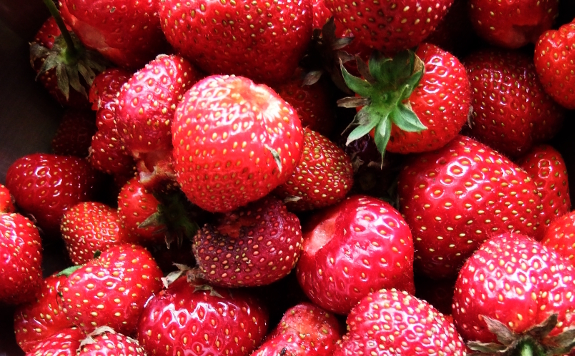
Like most edibles,
strawberry plants love water. But irrigating them is a tricky endeavor
because sugars decline dramatically for a day or so after watering.
My solution is to divide the garden into three zones. I pick all the
ripe fruits in zone A on day 1, then I water zone A on day 2 while
picking all the ripe fruits from zone B. Day 3 involves picking in zone
C and watering in zone B, etc.
By the time I circle back around, the ground is moist and the
strawberries are once again sunkissed and delicious. Yum!
We loaded up the big ladder
today for some off the farm climbing.
It rides nicely on top if
both sides are secured firmly.
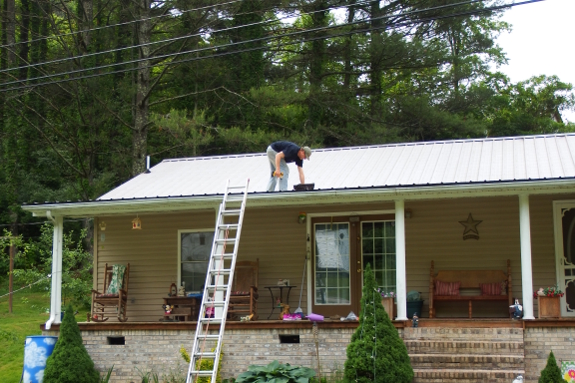
This appears to be the
season for assessing leaky roofs --- three roofs in three weeks!
Kayla's wins the prize for being the easiest to work on, with its
nearly flat porch acting as a landing pad.
Everyone in our circle should be snug and dry for a while yet. But Mark
still has most of a can of elastomeric
roof compound left,
so I guess we'll be on call until it's all gone.
A close up view of the
elastomeric roof repair.
I checked it after a week of
setting and it seems to have bonded properly.
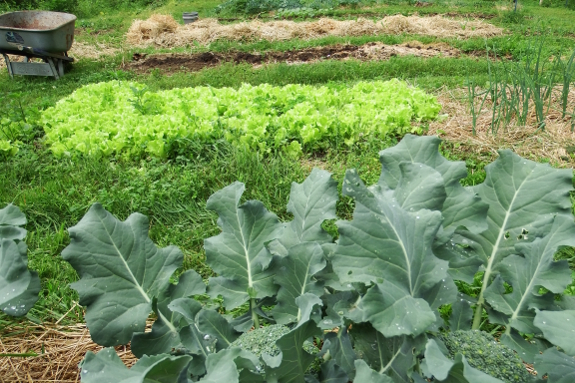
This is the time of year
when planting, weeding, and harvesting begin to run together into one
big green blob. After a month of kale, swiss chard, lettuce, and
asparagus, suddenly the flood gates begin to open with the first big
harvests of strawberries and broccoli.
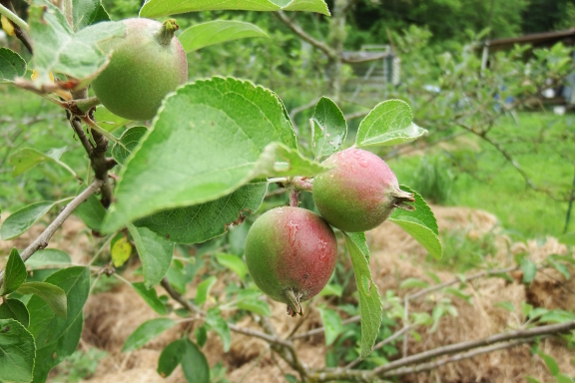
Meanwhile, snap peas
will be ready to add to our salads next week, while raspberries and
blueberries are getting big. Our tree fruits mostly got nipped once
again despite a very early last frost, but a few trees have young
fruits that are growing nicely. Such a bounty plumping up in our garden!
The Kubota dump bed along with a good hand winch made loading up this heavy stove kind of easy.
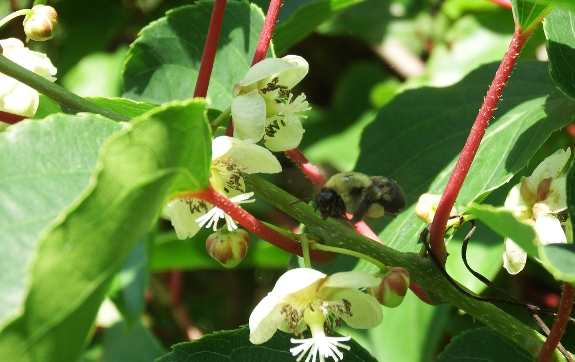
The hardy kiwis are
finally blooming, and the bumblebees found them before I did! For those
of you keeping track at home and waiting for your own vines to fruit,
our kiwis have been in the ground for nine long years. So the report
that hardy
kiwis bear in two years from cuttings didn't quite pan out in our
neck of the woods.
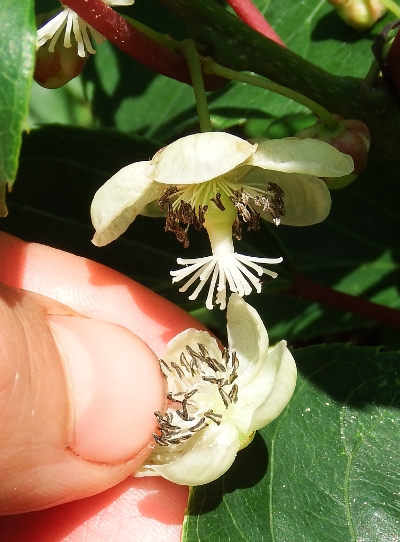 One
of our female vines flowered two years ago, actually, but without a
male flower no fruit was set. That's despite the stamens clearly
visible in the female flower (shown at the top of the image on the
right).
One
of our female vines flowered two years ago, actually, but without a
male flower no fruit was set. That's despite the stamens clearly
visible in the female flower (shown at the top of the image on the
right).
Now that we have male
flowers (one of which I'm holding near the bottom of the photo), I can
see the difference --- the males definitely go all-out on the
pollen-production front. Fingers crossed this is the year we taste
homegrown kiwi fruits!
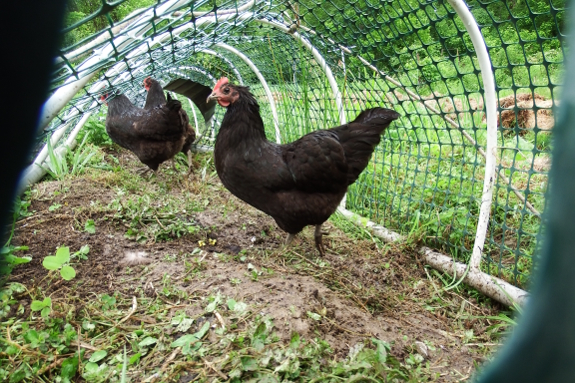
It took a few days for our flock to learn how to use the new PVC chicken feeder, but once they did it they seem to be saving about 20 percent compared to the old method of tossing the feed in fresh grass of that morning.
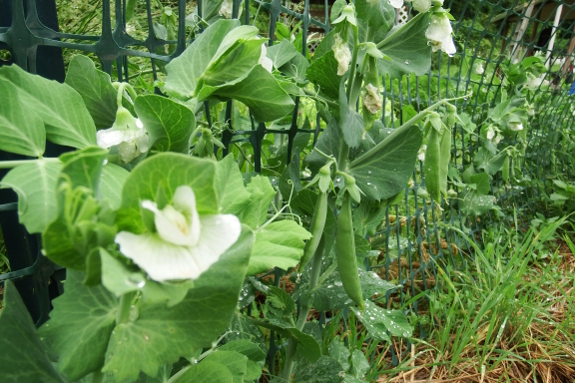
Even after a decade,
we're still trying to find the best edible-pod pea for our garden. But
2017 might be the year that makes the cut!
We started out growing
Mammoth Melting Sugar, but those were really snow peas (to be eaten
when the pod is flat) rather than sugar snaps (to be eaten when the pod
is plump.) So we tried Sugarsnap and Super Sugar Snap, which did indeed
give us that sweet crunch we were craving...but also quickly succumbed
to a blight that wilted the plants from the bottom up before they were
done bearing.
Enter Sugar Sprint. The
pods are plump and sweet, the vines are short but prolific, and so far
their reputed resistance to powdery mildew seems to be holding true.
Maybe these will be the perfect peas for us?
We've been using the new
Honda GCV 190 mower a lot this month.
It's been flawless so far.
Starts on the first pull
every time thanks to the Automatic Choke feature.
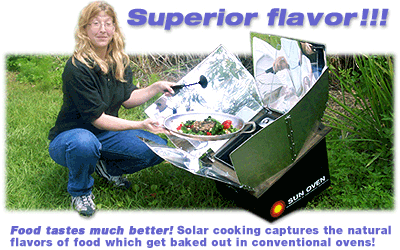 I've always been intrigued by
sun ovens, but I have to admit my one childhood experiment with the
topic turned me off. We lined the inside of a cardboard box with
aluminum foil, put a sheet of plexiglass on top, then watched as our
food...sat there.
I've always been intrigued by
sun ovens, but I have to admit my one childhood experiment with the
topic turned me off. We lined the inside of a cardboard box with
aluminum foil, put a sheet of plexiglass on top, then watched as our
food...sat there.Luckily, other experimenters were more successful. Paul Munsen from Sun Ovens International has developed a pretty fancy solar cooker, along with plenty of excellent techniques to ensure your meals come out tasty (and not stone cold). He sums his experiences up in free video seminars which cover everything from which type of pot to use and whether to preheat all the way up to using solar ovens for non-cooking tasks like purifying drinking water.
And, yes, I'll admit, he tries to sell you one of his sun ovens too (for a discount). But the information portion of the seminar is valuable in and of itself.
Which brings me to your opportunity to watch, ask questions, and learn. Mark and I are hosting an hour-long video seminar with Paul on Wednesday, May 31, starting at 7:00 p.m. Central Daylight Time, (8 p.m. EDT / 6 p.m. MDT / 5 p.m. PDT). It's free and by invitation only (although you can tell your friends if you want to join up together), so please head over here if you'd like to preregister.
See you there!
I caught another egg eating
hen today in the act of trying to access the egg area.
She's isolated for now to see
if she's the only one.
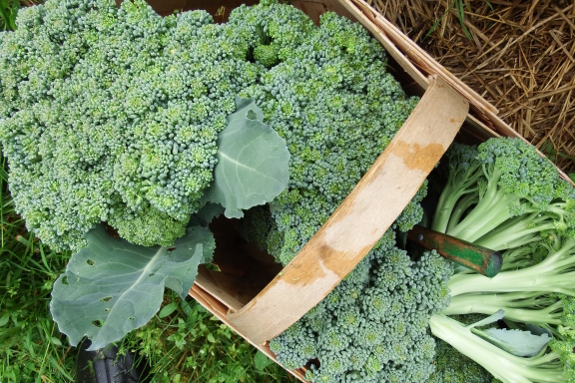
Cutting
the size of our planting area in half and focusing on our predictably
heavy producers has
been a life-saver this spring. Last summer, I'd gotten to the point
where the work-to-reward ratio in the garden was tipping toward "not
worth it." But this year, mornings in the garden are delightful, full
of planting, weeding, mulching, and harvesting crops that I'm 90% sure
will make the journey from seed to plate without too much work on my
part. Success!
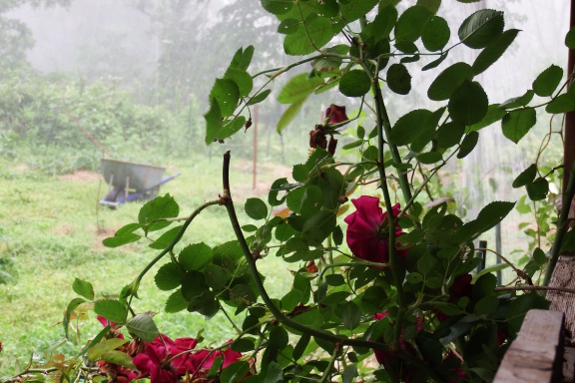
First the roar of rain
and wind tear across our homestead...then the backup battery begins
beeping its countdown warning as the power goes out. Quickly, I shut
everything off, wanting to save our few remaining ounces of juice for
the bare necessities --- making blog posts and charging my kindle. Then
I go out to pick some strawberries for supper, noticing how different
the world sounds without power.
We added two eye level horizontal stretches of wire to train our front grapes on.
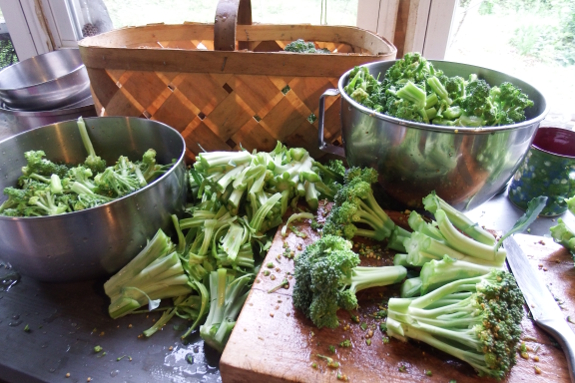
Despite cutting
back on most parts of the garden, we kept our broccoli plantings
the same. They're just such a perfect crop --- tasty, productive, and
easy to manage.
After gorging ourselves on huge heads all week, I packed 22 blanched
pints away in the freezer for later. Two-thirds down and one-third to
go!
The recent storm we had was
heavy enough to flood my new PVC
chicken feeder.
I adjusted it to a drier
location and added some side protection.
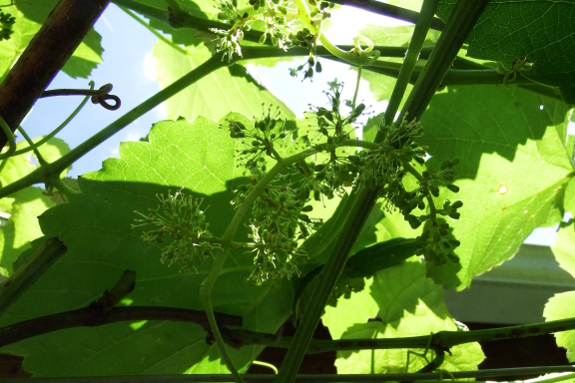
Although training grapes
outside our main bank of windows was intended as a way of shading the
summer trailer, I've gotten just as much of a kick out of watching the
plants through the seasons. Grape flowers are so small that I've always
missed them in the past, but their windowside location means that I've
had a front row seat as our Reliance vines break out into bloom this
time around.
The visibility also
means I noticed the first signs of phomopsis
and snipped off the affected leaves and vines. Here's hoping that
despite the near constant rain, I acted fast enough to keep this fungal
disease in check.
Is there anything to do to prevent carpenter bees from tunneling into the porch?
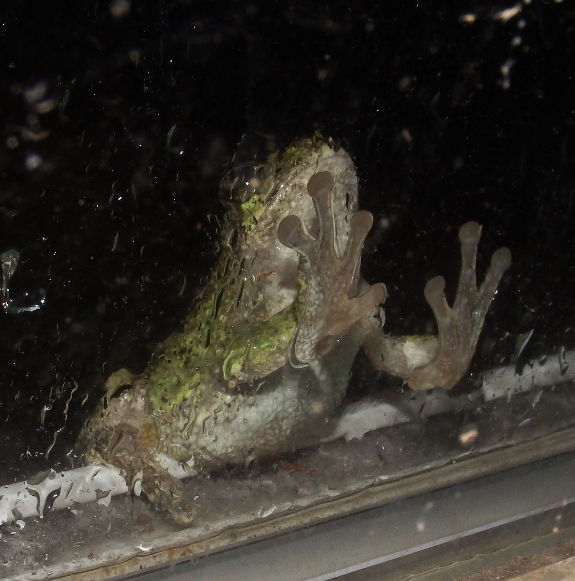
How is the new horizontal
trellis stretch of wire supported?
A loop of wire supported at
the top eye bolt comes down to hold the weight.
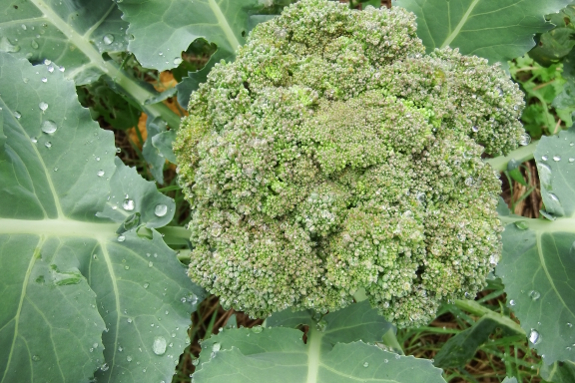
Several of you asked very
astute questions on
my broccoli post last week. Let's see if I can some up the answers all
in one post.
In terms of variety selection, I haven't really
hit a dud yet...but I also choose those that promise one big head
(since you can always get multiple smaller heads later after cutting
the main event). I've grown Packman, Marathon, and Blue Wind, and as I
recall they all did great for me. Blue Wind is the variety we're
growing this year.
Planting dates will vary widely
depending on where you live and what type of spring you're
experiencing. I've had best luck starting mine inside at the beginning
of March, then transplanting into the garden as soon as there will be
no lows below 28. This year, that date came early --- March 27.
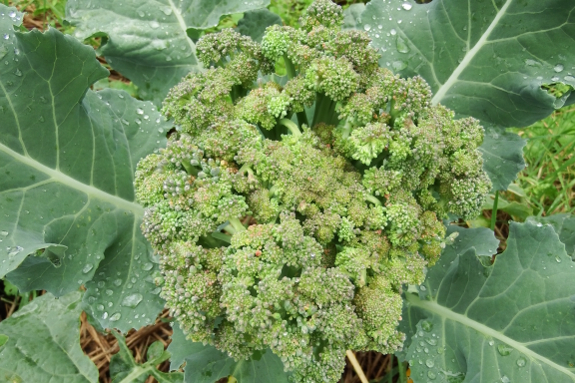
And then there are the
questions none of you asked, but which I think are equally important to
producing good broccoli. First --- food.
Broccoli is a very hungry crop, so the more you can feed them the
better. They also need full sun
to put on those fast growth spurts before the bugs hit.
Which brings me to the
biggest problem organic growers will have with broccoli --- caterpillars. The big green cabbage worms
actually don't bug us much as long as we plant early and I squash the
few I notice, but the less obvious southern cabbage worms can be a
doozy. See that head in the second photo above with spaces between its
florets? Southern cabbage worms have been eating it from the inside
out, and they're a bear to clear out of the head in the kitchen too.
The solution to cabbage
worms (assuming you don't want to spray insecticides) is planting early
and keeping your garden crucifer-free in the summer months. If you can
harvest your broccoli before the beginning of June, you probably won't
have to deal with many southern cabbage worms. And if you pull the
spring plants soon thereafter rather than letting them push out an
extra floret or two throughout the summer months, cabbage worms won't
be able to get a foothold on your garden and be ready to hit the ground
running next year.
If all else fails, don't
despair --- there's always the fall crop! Start seeds inside around the
middle of June and you'll be eating another round of broccoli before
you know it. Good luck!
I had a hen escape on me when
I was moving the wheelchair chicken tractor to a new spot last night.
Next time I'll wait till they
are all roosted before moving it long distances.
Today we developed a new
procedure to herd escaped chickens back in to a new flap in the back
while the rest of the flock is secure in the other half of the run.
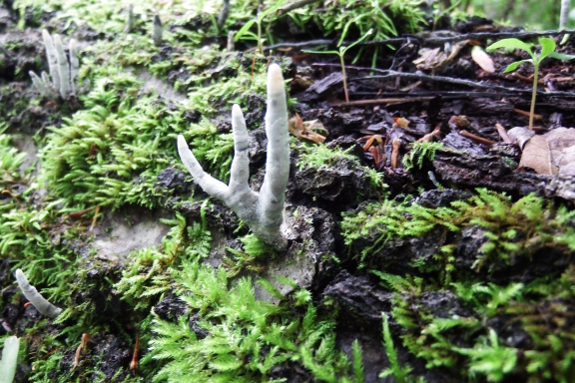
After installing an
air-conditioner, I sat back...and watched the weather turn cool and
wet. A low of 51 last week was enough to send me scurrying to the wood
stove to burn some junk mail, and the goats turned grumpy as their
dining was interrupted repeatedly by everything from sodden grass to
actual storms. Good thing the weather cleared up at the end of the week
so we could all enjoy the necessities --- a hike for me, gorging on dry
plant matter for them.
The recent power outage
motivated me to find a place to mount our solar panels.
The red cable should be
enough tension to handle moderate levels of wind.
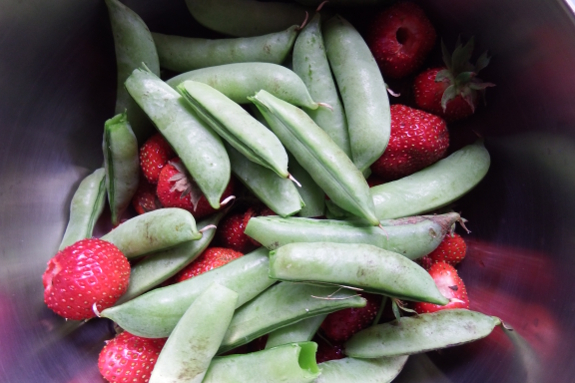
Our berry cascade is
getting ready to change its melody. Strawberries are still rolling in
but...
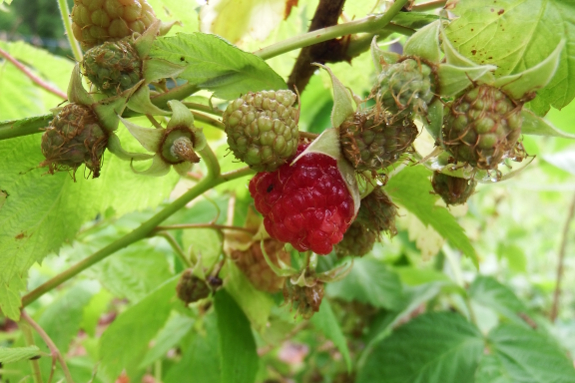
...we ate the first red
raspberry Sunday.
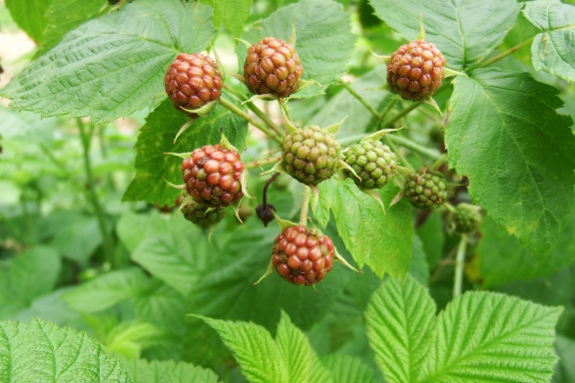
Meanwhile, black
raspberry bushes are absolutely loaded and the first few fruits are
beginning to blush red.
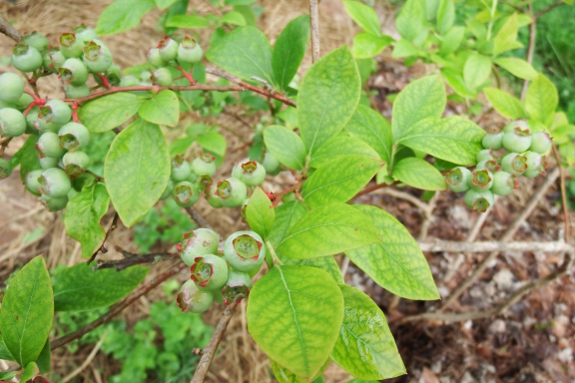
The surviving
blueberries are similarly laden with young fruits despite their winter
transplant. One of the three is showing an iron deficiency due to
high pH, though, so I consulted The
Ultimate Guide to Soil
and ordered some iron sulfate to speed up the pH
transition. (Yes, I do look for answers in my own books. That's the
point of writing them, right?)
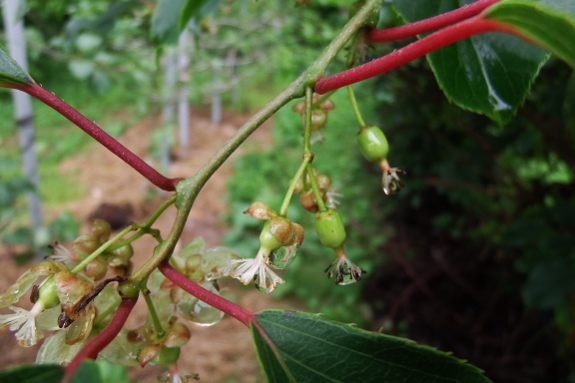
Meanwhile, in the kiwi
bower, petals are beginning to drop...and plump ovaries are being
left behind. I'm still trying not to count my kiwis before they ripen,
but conditions are looking good for a first harvest this year sometime
in October.

I'm going to be hosting an online
seminar about cooking with a solar oven tonight at 8 pm EDT.
I talked with Paul the other
day and he seems very nice and confident in his product.
Please consider joining me if
you've got the time and interest. There will be an opportunity to ask
him questions and he's giving a discount on the oven he sells.
Image credit goes to Wikipedia.
Want more in-depth information? Browse through our books.
Or explore more posts by date or by subject.
About us: Anna Hess and Mark Hamilton spent over a decade living self-sufficiently in the mountains of Virginia before moving north to start over from scratch in the foothills of Ohio. They've experimented with permaculture, no-till gardening, trailersteading, home-based microbusinesses and much more, writing about their adventures in both blogs and books.
